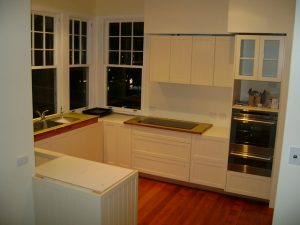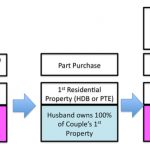Once you have had a chance to review your kitchen remodeling tips, remember to use a budget calculator to fine tune your own budget
It can be challenging to determine the amount you should reasonably be spending on your kitchen remodeling. Here’s one way to establish a basic budget.
- Step 1: Use your home’s value to determine a reasonable kitchen remodeling budget
- Step 2: Understand generally how your budget should be allocated
- Step 3: Understand the breakdown between the costs of goods and the costs of labor
- Step 4: Use budget calculator to establish a detailed breakdown of kitchen remodeling
Step 1: Using your home’s value to determine a reasonable budget for kitchen remodeling
Table of Contents

The 5 to 15% Rule
The 5 to 15% rule is a guideline that is widely accepted within the remodeling and building industries and can help you get a sense of what is reasonable to spend given the value of your home. The 5-15% rule states that the entire kitchen project should cost no less than 5% and no more than 15% of the current value of your home. The average would be 8%.
The basis of the rule is that if you spend less than 5%, there is a good chance you may be devaluing your home. If you spend more than 15%, there is a good chance you are overspending, and will not recoup your investment at a reasonable rate.
Things to consider in determining the percentage that works for you in your kitchen remodeling
Your evaluation of how much you spend should take into account the prominence of your kitchen within your home (the more prominent it is, the more impact it has on the value of your home), how much time you and your family spend in the kitchen and of course, how much you can afford. Up to a point, the higher quality home you live in, the higher a potential buyer’s expectation will be regarding the condition of the kitchen and the bigger the impact it will play in the appeal of the home.
Step 2: Determining how your budget should be allocated
How much you spend on kitchen remodeling must of course be based on your own means and priorities. But here is a rough guide:
- Cabinetry 48%
- Countertops 18%
- Appliances 15%
- Fixtures 6%
- Lighting and electrical 5%
- Flooring 5%
- Walls and Trim 3%
Example Case: A $1,500,000 home using 8% of the value for a budget:
- Home value: $ 1,500,000
- 8% budget: $120,000.00
- Cabinetry 48%: $57,600.00
- Countertops 15%: $18,000
- Appliances 19%: $22,800
- Fixtures 5%: $6,000
- Lighting and electrical: 5% $6,000
- Flooring 5%: $6,000
- Walls and Trim 3%: 3,600
Step 3: Understanding the costs of goods vs. labour
Of course, it is important to understand what a reasonable breakdown is for the costs of goods versus the costs of labour so that you can manage your project and carve out anything you plan to do yourself. Be mindful that the percentage for labor allocations are unique to each line item, and will vary with your choices and situation. 18% is a general industry average for cabinetry installation costs, but may vary according to your situation.
Additional costs you may need to budget for depending on your type of kitchen remodeling:
- Demolition If you are removing walls, or difficult-to-remove flooring, for example, additional costs may be incurred.
- Backplash If you are tiling a backplash, for example, these costs may need to be added.
- Work in adjacent areas If flooring or other work extends into other areas, this needs to be considered.
- General Contracting Depending on your situation, these fees may be covered by the above budget, or additional.
- Additional Appliances Additional ovens, cooktops, refrigerators, built-in coffee makers etc.
- Additional construction costs If you are moving walls, for example, you will need to consider those additional costs.
Nothing makes a home more desirable these days then a new kitchen with all the bells and whistles (well maybe good schools and neighborhoods are more important!). And most new homeowners either look for a home with a great kitchen or desire to renovate their kitchen at some point during the home ownership experience – hence our kitchen renovation guide.
The kitchen home renovation process is grueling, and if done correctly, very rewarding in terms of ROI and pleasure-factor (that is to say, how it feels to spend time in a new space). You can avoid some of the grueling aspects of the kitchen renovation process, but there is no way to avoid feeling frustrated, defeated, and upset during some stage of the renovation project – this is just a fact.
Whatever kitchen remodeling budget you have, do not use personal loans for it before searching for renovation loans.
In embarking in your renovations for that dream lifestyle and a nicer home, a good rule of thumb is not to leave too much of your own lifestyle in the house. The biggest mistake people make is do renovations that are very customised to their own wants and needs.
Personal loans are much more expensive than renovation loans. The interest rate is around six to nine per cent per annum. On the other hand, renovation loans can have interest rates of five per cent per annum or lower. You should always use the renovation loan first, and use personal loans only after it runs out.
Renovation loans are capped at $30,000, or six times your monthly income (whichever is lower). This is usually enough to furnish a five-room flat or smaller, if you don’t get overly lavish. To find the cheapest renovation loans, speak to some expert loan consultants. You should also source for good renovation contractors.






